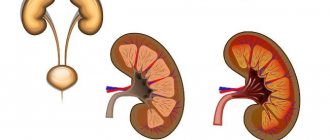Do you know what happens to your body when you endure the urge to go to the toilet for a long time? Obviously nothing good.
Surely each of us is familiar with such an awkward situation when you are “impatient”, but there is simply no way to go to the restroom. You're stuck in an hour-long traffic jam, making a report at an important business meeting, or walking along deserted streets at night on a romantic date... whatever! What to do in such a situation and how harmful is it to endure?
The average adult pee 4 to 7 times a day because the average adult bladder can hold up to 2 cups of fluid. Of course, we are all different, and how often you urinate may vary depending on your bladder capacity, bladder sensitivity, and the amount of fluid you consume.
As a rule, the urge to urinate is dulled during sleep, so if you visit the toilet more than twice at night, this may be a sign of bladder hypersensitivity or a number of other diseases.
Harm of urinary and defecation retention
The main task of the body regarding waste products is their timely removal. Therefore, enduring the urge to urinate or defecate is always bad, and even worse when it happens on a regular basis. First of all, it is impossible to avoid intoxication of the body due to the accumulation of acids and ammonia in the bladder, and feces and gases in the intestines.
If you put off going to the toilet for a long time, you can get constipation and, as a result, anal fissures and hemorrhoids. Regular long-term contact of the rectal mucosa with waste can lead to chronic inflammation in the organ, and then to cancer.
If you do not empty the bladder for a long time, the walls of the organ will stretch, and the receptors will no longer signal in time that it is time to relieve a minor need. A few more problems that may arise if you constantly endure “in small ways”:
- Formation of kidney stones. They are formed by waste that easily passes from an overfilled bladder into the kidney apparatus.
- Vesicoureteral reflux. This refers to the return of urine to the ureters and kidneys. Against this background, inflammation of the urinary organs develops.
- Dysfunction of the pelvic floor muscles. Normally, they hold urine and help get rid of it. By forcing your muscles to remain inactive for a long time, you will no longer feel the need to go to the toilet. However, you will feel tired, chills, and abdominal pain.
Involuntary loss of urine in women
Involuntary urination occurs much more often in women than in men. The main “provocateurs” of this condition are infections of the genitourinary system, pregnancy, gynecological ailments, etc.
Etiological factors:
Urinary incontinence in women
- menopause During this period, the secretion of estrogen in a woman’s body decreases, which negatively affects the functioning of some organs and systems, in particular the genitourinary system;
- elderly age. In older women, the tone of the bladder muscles decreases, which is why they lose the ability to fully retain urine. Urine may be released even when coughing;
- pregnancy with a large fetus or several at once;
- natural birth. Incontinence often occurs if the size of the child’s head was larger than the outlet itself from the pelvis. Such births are complicated, and are fraught not only with disturbances in urine output, but also with other pathologies;
- surgical intervention on organs localized in the pelvis;
- trauma to the perineum of varying severity, as a result of which the nerve structures of the pelvic muscles responsible for controlling the process of urine excretion were damaged;
- complete removal of the reproductive organ;
- obesity 3 or 4 degrees;
- injuries or inflammatory lesions of the spinal cord;
- constant lifting of weights due to work or sports;
- diabetes;
- chronic cystitis (often a provocateur of incontinence in women);
- conglomerates in the kidneys and bladder;
- prolonged constipation;
- chronic cough due to smoking or asthma. During coughing, the pressure in the abdominal cavity increases, which provokes the involuntary release of urine. In addition to coughing, involuntary urination is also observed when sneezing;
- diseases of the central nervous system.
In case of uncontrolled urine output, the woman should immediately go to see a urologist. Basic diagnostic methods:
- blood analysis;
- Analysis of urine;
- cystoscopy;
- X-ray of the urinary tract with contrast;
- gynecological examination;
- taking a vaginal smear;
- taking a smear from the urethra;
- Ultrasound of organs localized in the pelvis, as well as the kidneys.
Methods of treating pathology in women:
- drug therapy;
- prescribing special exercises designed to tone the pelvic floor muscles;
- installation of the uterine ring;
- surgery.
Why women can't be tolerated
Women should empty their bladder promptly to avoid cystitis and urethritis, which lead to a decrease in quality of life and even affect the ability to have children. It is especially harmful for pregnant women to restrain natural urges. An enlarged bladder puts pressure on the uterus, increasing its tone. This may cause bleeding or miscarriage.
Alternative Approach
Daily water needs vary from person to person. For example, if you are very active or live in a hot climate, you will naturally need more water because you lose water through sweat. But, there is a rule that will help you calculate how much water you need to consume. This rule says that you should drink as much water per day as you lose. Most adults lose about 6 cups of water per day through urination, and an additional 4 cups are lost through breathing, sweating and bowel movements. If you subtract the amount of water you consume with food, you will have an 8-cup deficit. By consuming 8 cups of fluid per day, you will be able to meet your needs.
Vesicoureteral reflux
Vesicoureteral reflux is a very serious problem to be aware of and can occur due to poor urinary habits.
This disease occurs when urine , instead of being removed from the body after being in the bladder for some time, returns back to the urethra and kidneys. It causes serious infections.
Typically, vesicoureteral reflux has several stages, from I to V, depending on the severity of the case. In the first phase, the lightest, urine reaches the ureters. But when urine reflux reaches the kidneys every day, we can already talk about phase V.
This is indeed very serious, since in addition to possible infections, serious harm to the kidneys can be caused. Keep this in mind!
Bladder enlargement
As a rule, the bladder holds from 150 to 200 ml of liquid (depending on the individual characteristics of the body). When the bladder is full, receptors are activated that send a signal to the brain that it is time to go to the toilet. Then the brain, in turn, activates a feeling of discomfort, and sometimes even pain, so that we immediately go to empty our bladder.
What happens if we don't? What happens if we don't listen to our brain? If we continue to do something, overcoming our natural desire? Will we also drink and eat, thus allowing fluid to accumulate in our body? The walls of our bladder will continue to move apart... This is not the safest phenomenon, and you should be aware of it.
Vesicoureteral reflux (VUR)
This is another very serious problem. It's simple - the liquid, having no outlet, rises back into the ureters. VUR has five degrees:
- The reverse flow reaches only the ureter;
- The reverse current reaches the kidney;
- Accumulated urine dilates the ureter;
- A limescale deposit appears;
- The functions of the kidney are impaired, and the internal tissues of the kidney become thinner.
This condition threatens infection in organs and more serious irreversible consequences: renal failure, nephrosclerosis. These complications are easy to avoid; you just need to visit the toilet on time.
In addition, the body will still take its toll and after prolonged torment it will give a signal to the brain that it is necessary to relax the internal sphincter, regardless of your permission.
What's the worst thing that can happen if you wait too long?
Ordinary patience will not burst your bladder, experts write. However, if it is very overfilled, it can burst from external influence: a blow or a sudden movement with tension in the press. The most common causes of bladder damage are road accidents, falls from a height, or heavy objects falling on a person's lower abdomen. In this case, there is a high probability of death.
There is a known case in history of death from excessive patience, however, over the years, the story could have been embellished. Danish astronomer, astrologer and alchemist of the Renaissance Tycho Brahe. There is a legend that Brahe, following court etiquette, could not leave the royal table during the banquet, and died at the age of 51 (in 1601) from a ruptured bladder. The breakup did not occur at the event itself. After Tycho arrived home, it turned out that if he could urinate, it was only a little, and in terrible pain. On the night before his death, he rushed about in delirium, exclaiming that he hoped that his life had not been in vain.
Tycho Brahe
Physiologically, doctors agree that rupture of the bladder cannot occur with arbitrary sphincter tension.
“The worst thing is that with regular patience, inflammatory processes and bladder pain syndrome can develop,” shares Dr. Benjamin Brooker.
The harm of prolonged patience
Often the danger of going to the toilet for a long time is indicated for girls, but it is important to consider that this is no less dangerous for boys. The risk of cystitis is higher in women due to the structure of the urinary canal and bladder. In men, with prolonged patience, not only inflammation, but also prostatitis can occur.
For women, the risk of toilet abstinence increases during pregnancy. An enlarged bladder puts pressure on the uterus and causes active contractions, which can lead to miscarriage.
Muscle strain and congestion
If you endure it often, the bladder walls will stretch and weaken. In youth, no pathologies will arise, but after 40 years, this is fraught with a high risk of infection, blood poisoning and intoxication. This is due to the fact that acids begin to penetrate through the thinned mucous membrane, causing the formation of ulcers and erosions.
Against the background of constant exposure, mutated cells may appear, which over time degenerate into tumor tissue. Prolonged patience is a harbinger of stagnation. And this increases the risk of forming stones in the bladder.
Dangerous infections
Severe pain may be associated with bacterial cystitis, which occurs due to excessive accumulation of microorganisms in the urine. Since the liquid consists of sulfates, acids, creatine, chlorides, phosphates and urobilin, bacteria multiply most actively in it. If you don't empty your bladder often, it can lead to pyelonephritis, which is kidney damage.
Stones in the filter organ
If urine does not leave the bladder frequently and for a long time, it may rise back into the kidneys. This concentrated mixture, filled with mucus, broken down proteins, salts and minerals, settles in the filter organs. Because of this, stones can be found not only in the bladder, but also in the kidneys.
The reverse rise of urine is called vesicoureteral reflux, or VUR. It is accompanied by several stages:
- Urine affects only the ureter.
- The fluid reaches the kidney.
- The accumulations dilate the ureter.
- Calcareous sediment appears in the canals and kidneys.
- Organ function deteriorates, internal tissues become thinner.
Advanced cases of the disease lead to the development of nephrosclerosis and renal failure. Pain during VUR becomes so intense and prolonged that a person no longer has doubts about the presence of a disease of the urinary system.
The diseases described will not arise from a single abstinence. However, with a constant, long-term absence of urine outflow, the risk of developing pathology increases to 80-90%, especially if the condition is combined with a decline in immunity, for example, during colds.
The norm for going to the toilet in small ways
Before considering the causes of frequent urination, you need to evaluate whether we are really talking about frequent urination. To do this, familiarize yourself with the physiological norms:
| Gender, age | Frequency of urination per day | Daily urine volume | Average volume of urine per 1 urination |
| Adult men | 4-6 | 750-1600 (75% of the liquid drunk per day) | 200-300 ml |
| Adult women | 4-8 | The same amount increases during pregnancy | The same amount grows during pregnancy |
| Children 0-28 days | up to 25 | 170-500 ml | Should be 2-2.5 ml/kg/hour, which is divided by the number of urinations |
| Up to a year | to 10 | 250-810 ml | |
| 3-5 years | 6-8 | 600-900 ml | |
| 5-10 years | 5-7 | 700-1200 ml | |
| 10-14 years | 4-6 | 1000—1500 ml |
These are the values that should be observed under the following conditions:
- human body temperature – 36.2-36.9°C;
- ambient temperature – less than 30°C;
- 30-40 ml/kg of body weight was drunk (this figure will be different for children under one year of age);
- did not use diuretics in tablets, as well as rosehip decoction, coffee, green tea in large quantities;
- no shortness of breath and/or rapid breathing.
At the same time, a person should not urinate at night, a maximum of 1 time, and the volume of urine excreted should not exceed 200-300 ml in an adult.
Advice! If your or your child’s numbers are higher than the above norm, then in order to understand the etiology of this condition, you need to measure the total volume of daily urine, and also pay attention to the accompanying symptoms. Further we will consider frequent urge to go to the toilet in conjunction with these signs.










